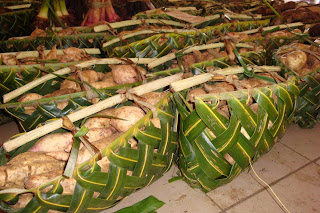Bob Bates was on hand to welcome the Comanche-5 when we landed at Mount Hagen. Bob is the Managing Director of
Trans Niugini Tours and at 73 years of age is an avid aviator and adventurer. Only a few weeks earlier Bob had flown his Baron (P2-BOB) in a circular route over the South Pacific as far east as the
Marquesas Islands and back to his base at Mount Hagen. Bob has chronicled some of his many flights which can be viewed
via this link. Early next year Bob plans to circumnavigate South America with a friend flying in a Cessna 182.
 |
| Bazflyers' route through PNG |
Two nights at Bob's Rondon Ridge lodge, a wonderful retreat sited high above the Wagi Valley, was a welcome relief from the hot and humid coastal climate. Last stop on our Coral Sea Safari was Bob's wildlife lodge, Bensbach which is situated in the far south-west corner of Papua New Guinea. The weather on this sector proved mildly challenging. Taking-off from Mount Hagen airport at an elevation of 6,000 feet, we settled BAZ in at an altitude of 9000 feet then for much of the next hour zigzagged either side of track weaving our way among towering cumulus clouds.
 |
| Bensbach Lodge |
Bensbach is a wildlife wonderland. It is also accredited with being the Barramundi capital of the world so any visit would not be complete without a fishing expedition. We departed down river by flat bottom boat in the pale light of dawn passing awaking villages, deer and wallaby by the hundreds, crocs sliding off the river banks and teaming bird life. It took several hours but we did land our Barramundi which weighed in at 6kg…all credit to a skilled local fishing guide. That night we dined on the freshest Barramundi ever, reminisced on the past six weeks and bid emotional farewells. Bensbach marked the last night on our Coral Sea Safari and the successful completion of a great flying adventure….some might even say the flight of a lifetime! Six weeks, 6 countries, five Comanches and 10 adventurers.
 |
| BAZ fishing |
 |
| 6kg of Barramundi |
Thursday morning, a 50 minute flight to Daru for exiting Customs and Immigration formalities, then a 45 minute hop across the Torres Strait to Horn Island and entry formalities into Australia….the Coral Sea Safari was over! Jim Peters (VH-ESL) and Jim Barry (VH-DCB) began their respective journeys home. Ian, Irene, Tony, Jan and the Bazflyers were looking forward to a couple of nights stay on Horn Island.
 |
| Bazflyers at Bensbach |
Since leaving home base in Taupo, New Zealand, ZK-BAZ has flown 30.5 hours.















































